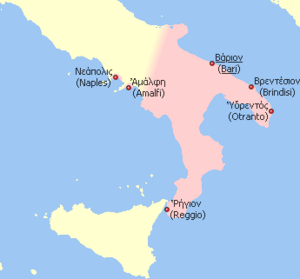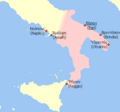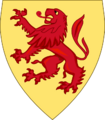Catepanate of Italy facts for kids
Quick facts for kids Catepanate of Italy
Κατεπανίκιον Ἰταλίας
|
|||||||||||
|---|---|---|---|---|---|---|---|---|---|---|---|
| Province of the Byzantine Empire | |||||||||||
| 965–1071 | |||||||||||
 Approximate territorial extent of the Catapanate of Italy during the early 11th century. Modern city names (in Italian, except from Napoli) are provided alongside the medieval Greek names. |
|||||||||||
| Capital | Bari | ||||||||||
| Historical era | Middle Ages | ||||||||||
|
• Established
|
965 | ||||||||||
| 1071 | |||||||||||
|
|||||||||||
| Today part of | Italy | ||||||||||
The Catepanate of Italy (which in Greek was Katepaníkion Italías) was a special area, like a province, that belonged to the Byzantine Empire. It existed from 965 to 1071. At its biggest, it covered the southern part of mainland Italy. This area stretched from Monte Gargano down to the Gulf of Salerno. Even cities like Amalfi and Naples were loyal to Constantinople, the capital of the Byzantine Empire. The modern Italian region of Capitanata gets its name from katepanikion.
Contents
What Was the Catepanate?
The Catepanate was a very important part of the Byzantine Empire in Italy. It was ruled by a special governor called a katepano (or catepan). This word meant "the uppermost" in Greek. The catepan was usually a high-ranking military leader. This system was put in place to help the Byzantines keep control of their lands in southern Italy.
A Quick Look at Its History
For almost a hundred years, the Byzantine Empire didn't have much power in southern Italy. This changed when Basil I became emperor in 867. He wanted to make the empire strong again.
Byzantines Return to Italy
Starting in 868, the Byzantine navy and diplomats worked hard. Their goals were to protect the Adriatic Sea from raids and to get back control of parts of Italy. They succeeded in taking Otranto from Arab raiders in 873. Also, Bari, a city that had been captured by Emperor Louis II of Italy, came under Byzantine control in 876.
A skilled general named Nikephoros Phokas the Elder helped a lot. In the 880s, he expanded Byzantine control over most of Apulia and Calabria. These victories helped the Byzantines become powerful in southern Italy again. Around 892, they set up a new region called the theme of Longobardia. Apulia, Calabria, and Basilicata stayed firmly under Byzantine rule for a long time.
The Catepanate is Formed
Around 965, a new region called Lucania was created. The military governor of Bari was then given the special title of katepano of Italy. This was done because the Byzantines had lost Sicily to the Arabs. They needed a strong leader to protect their remaining lands in Italy.
The Normans Arrive
In the early 1000s, some Norman adventurers came to southern Italy. They were on a religious journey. These Normans were fierce fighters. In 1017, they helped the local Lombard cities fight against the Byzantines.
From 1016 to 1030, the Normans worked as soldiers for hire. They fought for either the Byzantines or the Lombards. In 1030, Duke Sergius IV of Naples gave their leader, Ranulf Drengot, a fortress called Aversa. This was the first time the Normans had their own land in southern Italy. From here, they began to conquer the region.
Two brothers, William and Drogo, arrived in Italy in 1030. They joined the fight to take Apulia from the Byzantines. By 1040, the Byzantines had lost most of that area.
The End of Byzantine Rule
The Normans captured the city of Bari in April 1071. This event marked the end of Byzantine rule in Italy. It happened five centuries after the Byzantine Emperor Justinian I had first conquered parts of Italy.
Later, from 1154 to 1156, Emperor Manuel I Komnenos tried to get Italy back. The Byzantines even briefly besieged Bari again. They caused a large revolt that almost ended Norman control. But their efforts were not successful in the long run.
The title Catapan of Apulia and Campania was used again briefly in 1166. This was for Gilbert, Count of Gravina. In 1167, Gilbert used his power as catapan to force German troops out of Campania. He also made Frederick Barbarossa stop his attack on Ancona.
Important Catepans
Here are some of the people who served as Catepans of Italy:
- 970–975 Michael Abidelas
- 982–985 Kalokyros Delphinas
- 988–998 John Ammiropoulos
- 999–1006 Gregory Tarchaneiotes
- 1006–1008 Alexios Xiphias
- 1010–1016 Basil Mesardonites
- 1017 Leo Tornikios Kontoleon
- 1017–1027 Basil Boioannes
- 1027–1029 Christophoros Burgaris
- 1029–1032 Pothos Argyros
- 1033–1038 Constantine Opos
- 1038–1039 Michael Spondyles
- 1039–1040 Nikephoros Dokeianos
- 1040–1041 Michael Dokeianos
- 1041–1042 Exaugustus Boioannes
- 1042 George Maniakes
- 1045–1046 Eustathios Palatinos
- 1050–1058 Argyrus
- 1064–1068 Abulchares
- 1071 Stephen Pateranos
Images for kids
See also
- Magna Graecia
- Grecìa Salentina
- Katepanikion
- Catepanate of Ras





